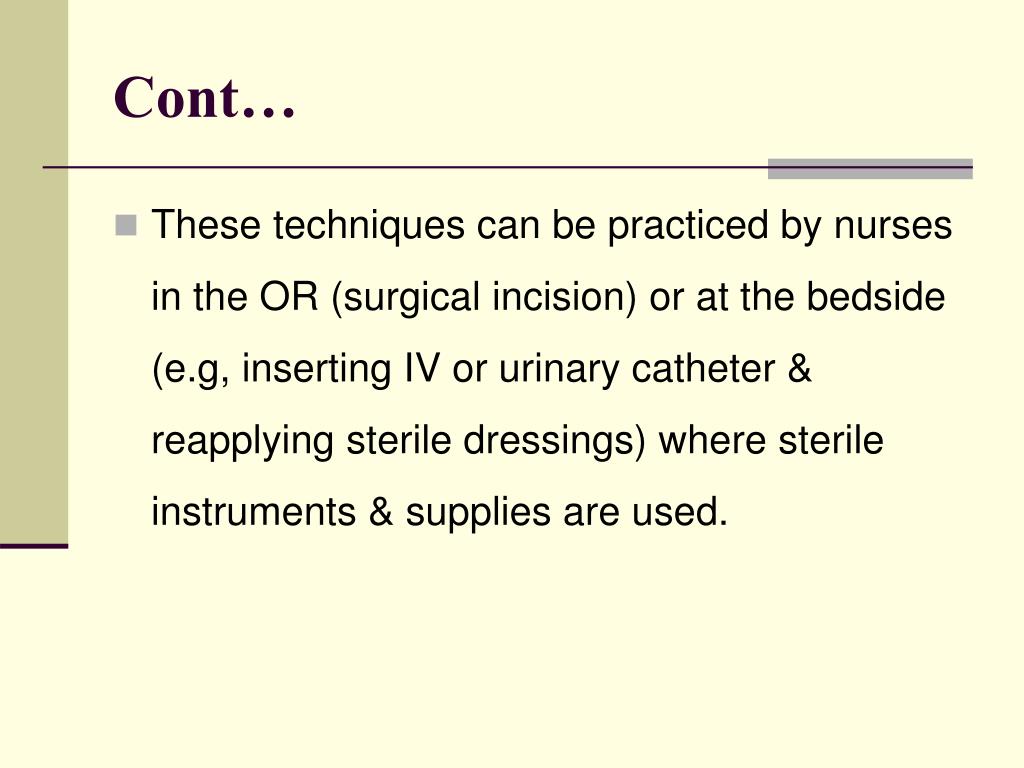
It is created by covering the patient’s body and bed or table that he/she lies on with drapes made of sterilized fabric or synthetic sheets.
#Example of medical asepsis skin#
When the skin or mucous membranes are breached (surgery, insertion of IV or Arterial lines, lumbar puncture, insertion of epidural catheters) Managing traumatic and surgical wounds catheterisation, endoscopy, endoscopic surgery, insertion of intraperitoneal / Tenckhoff catheters)
#Example of medical asepsis free#
Where a body canal or cavity normally free of microorganism (like trachea, bronchus, urethra, bladder, ureter, kidney pelvis and calices, uterine cavity, CSF and peritoneum), is entered (e.g. Strict adherence to aseptic technique is indicated when performing invasive procedures including those: Therefore, efforts must be made to reduce the breach of aseptic technique to the minimum. Immunocompromized (Neutropaenic) patients, babies, the elderly, diabetics and malnourished patients are especially at risk. The development of infection is also dependent on the type of organism.Īnother factor is the immunity of the host. However multiple breaches would result in a cumulative effect leading to the quantity of bacteria reaching a significant level for the development of infection. shortening duration of retention of catheters / drainsĪ single breach of aseptic technique may introduce only a small quantity of microorganism and may not lead to a serious outcome because the small numbers may be taken care of by the host defense mechanism.minimizing tissue injury and ischaemia including excessive use of diathermy and sutures that are too tight.Reducing predisposition of host to infection by:.Prevention of re-contamination of sterilized or disinfected instruments by avoiding contact between sterile and non-sterile items.Reduction of bacteria on the care provider especially the hands through hand washing, gowning and wearing sterile gloves.

Reduction of bacteria at the point of entry (skin or mucosa of patients) of the host through the use of antiseptics.Minimizing the amount of microorganisms and dust in the environment through general cleanliness of rooms, air and equipment.

The interplay between the factors can be represented by the equation.įactors Influencing Development of Infectionĭuring the performance of clinical procedures, the prevention of infection are be achieved through approaches based on the facts mentioned above. Organisms can be transferred (transmitted) from one location (animate and inanimate) to another through the air, via droplets, and, most importantly, through contact.Organisms can either be reduced in number by disinfection or removed entirely by various sterilization methods.

Some species consistently cause infection while others cause infection only in certain conditions and situations. Infection is caused by microorganisms (Bacteria, fungi, protozoa & viruses). Since they cannot be seen with the naked eye their presence should be assumed. Microorganisms are everywhere in the environment. BASIC FACTS RE: MICROORGANISMS & INFECTION

The correct practice of this technique requires the understanding of some principles and facts. The aseptic technique is a method of preventing the transmission of infection to the patient during the performance of various clinical procedures.


 0 kommentar(er)
0 kommentar(er)
